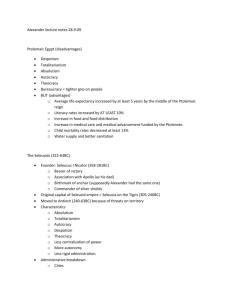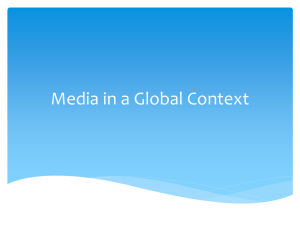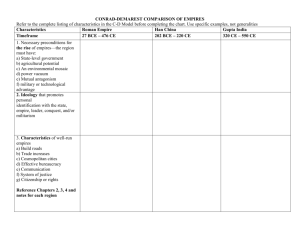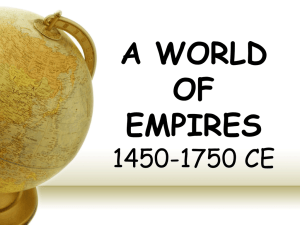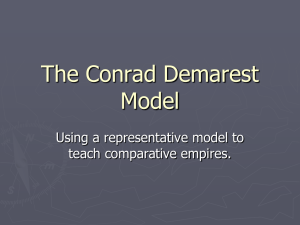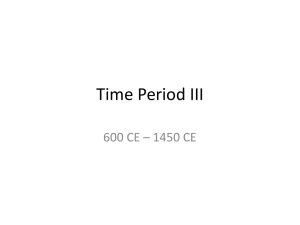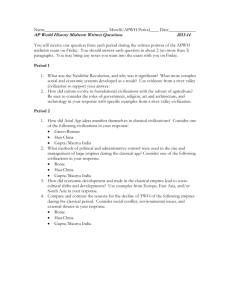Government and State Structures Comparison
advertisement
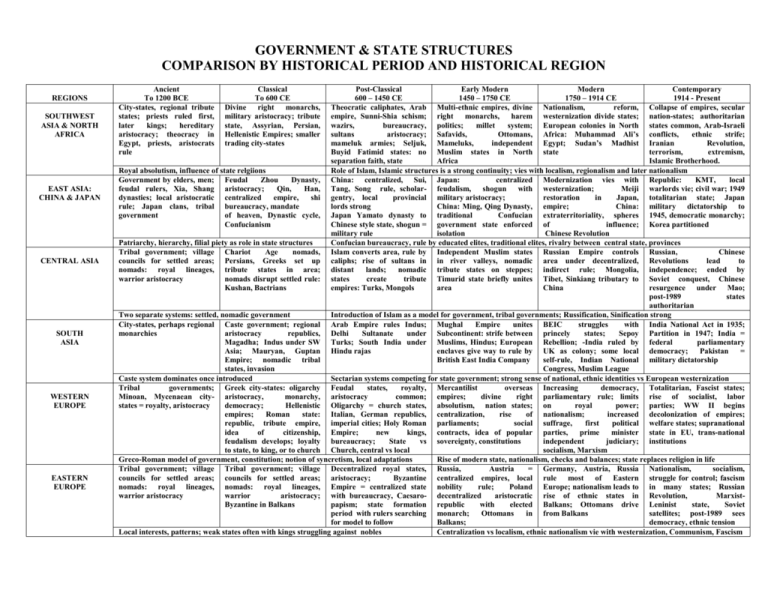
GOVERNMENT & STATE STRUCTURES COMPARISON BY HISTORICAL PERIOD AND HISTORICAL REGION REGIONS SOUTHWEST ASIA & NORTH AFRICA EAST ASIA: CHINA & JAPAN CENTRAL ASIA SOUTH ASIA WESTERN EUROPE EASTERN EUROPE Ancient To 1200 BCE City-states, regional tribute states; priests ruled first, later kings; hereditary aristocracy; theocracy in Egypt, priests, aristocrats rule Classical To 600 CE Divine right monarchs, military aristocracy; tribute state, Assyrian, Persian, Hellenistic Empires; smaller trading city-states Post-Classical Early Modern Modern Contemporary 600 – 1450 CE 1450 – 1750 CE 1750 – 1914 CE 1914 - Present Theocratic caliphates, Arab Multi-ethnic empires, divine Nationalism, reform, Collapse of empires, secular empire, Sunni-Shia schism; right monarchs, harem westernization divide states; nation-states; authoritarian wazirs, bureaucracy, politics; millet system; European colonies in North states common, Arab-Israeli sultans aristocracy; Safavids, Ottomans, Africa: Muhammad Ali’s conflicts, ethnic strife; mameluk armies; Seljuk, Mameluks, independent Egypt; Sudan’s Madhist Iranian Revolution, Buyid Fatimid states: no Muslim states in North state terrorism, extremism, separation faith, state Africa Islamic Brotherhood. Royal absolutism, influence of state relgiions Role of Islam, Islamic structures is a strong continuity; vies with localism, regionalism and later nationalism Government by elders, men; Feudal Zhou Dynasty, China: centralized, Sui, Japan: centralized Modernization vies with Republic: KMT, local feudal rulers, Xia, Shang aristocracy; Qin, Han, Tang, Song rule, scholar- feudalism, shogun with westernization; Meiji warlords vie; civil war; 1949 dynasties; local aristocratic centralized empire, shi gentry, local provincial military aristocracy; restoration in Japan, totalitarian state; Japan rule; Japan clans, tribal bureaucracy, mandate lords strong China: Ming, Qing Dynasty, empire; China: military dictatorship to government of heaven, Dynastic cycle, Japan Yamato dynasty to traditional Confucian extraterritoriality, spheres 1945, democratic monarchy; Confucianism Chinese style state, shogun = government state enforced of influence; Korea partitioned military rule isolation Chinese Revolution Patriarchy, hierarchy, filial piety as role in state structures Confucian bureaucracy, rule by educated elites, traditional elites, rivalry between central state, provinces Tribal government; village Chariot Age nomads, Islam converts area, rule by Independent Muslim states Russian Empire controls Russian, Chinese councils for settled areas; Persians, Greeks set up caliphs; rise of sultans in in river valleys, nomadic area under decentralized, Revolutions lead to nomads: royal lineages, tribute states in area; distant lands; nomadic tribute states on steppes; indirect rule; Mongolia, independence; ended by warrior aristocracy nomads disrupt settled rule: states create tribute Timurid state briefly unites Tibet, Sinkiang tributary to Soviet conquest, Chinese Kushan, Bactrians empires: Turks, Mongols area China resurgence under Mao; post-1989 states authoritarian Two separate systems: settled, nomadic government Introduction of Islam as a model for government, tribal governments; Russification, Sinification strong City-states, perhaps regional Caste government; regional Arab Empire rules Indus; Mughal Empire unites BEIC struggles with India National Act in 1935; monarchies aristocracy republics, Delhi Sultanate under Subcontinent: strife between princely states; Sepoy Partition in 1947; India = Magadha; Indus under SW Turks; South India under Muslims, Hindus; European Rebellion; -India ruled by federal parliamentary Asia; Mauryan, Guptan Hindu rajas enclaves give way to rule by UK as colony; some local democracy; Pakistan = Empire; nomadic tribal British East India Company self-rule, Indian National military dictatorship states, invasion Congress, Muslim League Caste system dominates once introduced Sectarian systems competing for state government; strong sense of national, ethnic identities vs European westernization Tribal governments; Greek city-states: oligarchy Feudal states, royalty, Mercantilist overseas Increasing democracy, Totalitarian, Fascist states; Minoan, Mycenaean city- aristocracy, monarchy, aristocracy common; empires; divine right parliamentary rule; limits rise of socialist, labor states = royalty, aristocracy democracy; Hellenistic Oligarchy = church states, absolutism, nation states; on royal power; parties; WW II begins empires; Roman state: Italian, German republics, centralization, rise of nationalism; increased decolonization of empires; republic, tribute empire, imperial cities; Holy Roman parliaments; social suffrage, first political welfare states; supranational idea of citizenship, Empire; new kings, contracts, idea of popular parties, prime minister state in EU, trans-national feudalism develops; loyalty bureaucracy; State vs sovereignty, constitutions independent judiciary; institutions to state, to king, or to church Church, central vs local socialism, Marxism Greco-Roman model of government, constitution; notion of syncretism, local adaptations Rise of modern state, nationalism, checks and balances; state replaces religion in life Tribal government; village Tribal government; village Decentralized royal states, Russia, Austria = Germany, Austria, Russia Nationalism, socialism, councils for settled areas; councils for settled areas; aristocracy; Byzantine centralized empires, local rule most of Eastern struggle for control; fascism nomads: royal lineages, nomads: royal lineages, Empire = centralized state nobility rule; Poland Europe; nationalism leads to in many states; Russian warrior aristocracy warrior aristocracy; with bureaucracy, Caesaro- decentralized aristocratic rise of ethnic states in Revolution, MarxistByzantine in Balkans papism; state formation republic with elected Balkans; Ottomans drive Leninist state, Soviet period with rulers searching monarch; Ottomans in from Balkans satellites; post-1989 sees for model to follow Balkans; democracy, ethnic tension Local interests, patterns; weak states often with kings struggling against nobles Centralization vs localism, ethnic nationalism vie with westernization, Communism, Fascism REGIONS MESOAMERICA & CARIBBEAN SUB-AHARAN AFRICA SOUTH AMERICA SOUTHEAST ASIA, OCEANIA USA & CANADA Ancient To 1200 BCE Hunting bands, tribal government; Olmec royal absolutism with aristocracy, priests Classical To 600 CE Mayan city-states with royal absolutism, nobles, priests; tribute empire in Teotihuacan Hunting bands, tribal government elsewhere Post-Classical 600 – 1450 CE Some empire building in Mayan area; Toltec tribute state; Aztec Empire with royal absolutism, nobles, priests, clan/castes Early Modern Modern Contemporary 1450 – 1750 CE 1750 – 1914 CE 1914 - Present Spanish model: mercantilist French, American Mexican Revolution, Cuban empire, viceroyalty run by revolution leads to Revolution; Socialism, Iberian elites, local creoles independence; ideas of Marxism, democracy have local, limited influence; centralism, federalism, struggle against military church assists state; limited liberalism struggle; military rule; rise of democracy French, English influence rule, caudillos Tribal states coexist with more centralized royal states; kings powers limited by elites, priests Decentralized imperial state, issues: centralization, decentralization, reform; minority rights Stateless societies, tribal Kush Empire modeled on Mali, Songhay tribute Kanem Bornu, Hausa, European colonial empires Decolonization: 1956-89; government, royal lineages Egypt’s pharaoh; Axum, empires; Muslim models in Zimbabwe = tribute empire; rule Africa: direct, indirect most states ruled by tribal, continue throughout history Ghana: tribute empire; West, East; Swahili city- Forest area: gunpowder rule; Europeans rule thru traditional elites, most even when complex Bantu tribes migrate, tribal states; Kongo kingdom slaving empires, absolutism, local elites; apartheid in military or personal government arose structure centralized government bureaucracy; colonial South Africa; dictatorships; nation enclaves on coast building, identities thwarted by constant ethnic strife Weak state structures; power within clans, tribes, chiefs Tribute empires, local interests and systems, Islamic states Empires, colonies, resistance, adaptation of western models Hunting bands, tribal City-states with royal Royal absolutism, split Strong continuity by Incan French, American Socialism, Marxism, government absolutism, priestly class, inheritance; priests, Empire; rise of small revolution leads to democracy struggle against tribute empire aristocrats assist kings; city tribute, tribal states in rest independence; ideas of military rule; rise of states, small tribute empires of area often with kings; centralism, federalism, democracy; Peron’s = Chan Chan, Moche Spanish, Portuguese colonial liberalism struggle; military Argentina, Vargas Brazil = empires rule, caudillos state corporatism Tribal states coexist with more centralized royal states; kings powers limited by elites, priests Decentralized imperial state, issues: centralization, decentralization, reform; minority rights Tribal governments; Rise of royal chiefs, lineages; Tribute empires, trading Arrival of Islam brings European empires spread Decolonization, strong Vietnam = Chinese states with merchant Muslim models; some control; direct, indirect rule; nationalism; states = province; Funan first tribute aristocracy; Vietnam empire tribute states in Siam, only Siam = independent military, authoritarian empire; Indians bring raja, on Chinese model; Khmer Burma; European states est. protectorate of UK, Fr.; US Vietnamese revolution, Indian models but not castes Empire on Indian model colonies; Sp = Philippines; in Philippines communist state; new Dutch = Indonesia Malaysia, Philippines democratic republics; Islamic extremism Decentralization, weaker states; outside models from India, China but rarely social classes Strong influence of Islam, European models; local control by elites, adapting outside models Hunting bands, tribal Hunting bands, tribal City-states, tribute states British, French, Dutch Colonies give way to federal, Increased suffrage, strong government government based on Meso-American settler colonies under royal, con-federal democracies; civil rights, strongly antimodels: Moundbuilders, charter, and proprietary checks, balances, judicial central, pro-secular, party Anaszi, Iroquois rule; elite is mercantilist, oversight, 3 branches of democracies; ethnic Confederation planter aristocracy; government, civil rights diversity protected charters, self-government, private property critical Tribal structures, a few loose states, confederations; moving towards chiefdoms Decentralized imperial state Centralization, local interests; checks, balances, rights DEFINITIONS I. Paleolithic Government A. Stateless societies B. Tribal governments by strongest, best hunter, best provider, elder C. Women often could sit in councils, offer advice, lead II. Neolithic Government and Nomadic Councils A. Tribal councils dominate by males, largest land owner, owner of most animals in herding societies B. City-State: One city controls the agricultural land around it C. Nomadic societies often had two classes: aristocratic, commoners with rulers from a royal clan III. Ancient and Classical Government A. General Types of Government 1. Monarchy: Rule by King, either elected or inherited 2. Aristocracy: Rule by nobles born to position 3. Oligarchy: Rule by a few, often the wealthy, sometimes merchants 4. Democracy: Direct rule by popular vote; if rule by elected representatives is called a republic 5. Theocracy: Rule by a god-king of some type such as the pharaoh; Theocratic rule is usually through a priestly class 6. Gerontocracy: Rule by the elderly, common to East Asia B. Empires 1. Tribute Empire: A large conquest state which allows local rule, autonomy if taxes, tribute paid 2. Dynastic Rule: A form of monarchy where the ruler is chosen from a common family 3. Centralized rule: the head of state makes all decisions and rules through bureaucracy, aristocracy C. Caste Government 1. Birth castes determine social leadership 2. Most associated with South Asia but also common in Andean Americas, Mayan city-states D. Bureaucracy 1. Rule by specialists trained, educated to rule 2. Bureaucrats can also be military aristocracy, priestly caste IV. Post-Classical Government A. Feudalism 1. Decentralized rule based on warrior aristocracy, local justice, local control of land 2. Centralized Feudalism was practiced in Japan by Shoguns, military dictators B. Divine Right Monarchy, Divine Right Absolutism 1. Caliphates, Papal States, Christian Kingdoms of East, West Europe: God-inspired, ordained government 2. Privy Councils, curia, wazirs, sultans often exercised real power in name C. Warrior States 1. Power exercised through a warrior elite 2. Tends towards feudalism V. Early Modern Government A. New Style Monarchs 1. Often depend on non-traditional class for support, ie middle class in Europe 2. Exercise control through military, bureaucracy; struggle with traditional elites 3. Gunpowder States – empires established, ruled through firearms, military technology 4. Royal absolutism, divine right monarchies are a type B. Nation-State, nationalism 1. Developed in France; a state where one ethnic group dominates the state structure 2. Ideology of loyalty to a state, ethnic group rather than loyalty to a ruler, religion 3. Comes to include all classes irrespective of birth C. Multi-national state 1. A state with many ethnic groups, religious groups; nationalism a strong threat to these states 2. Millet government system in Turkey allowed local religious self-rule D. Modern Empires 1. Settler – mother country attempts to recreate mother culture abroad by sending settlers 2. Colonialism – control of other states for purposes of economic exploitation 3. Direct Rule: Distant colonies ruled directly from mother country, capital; often mercantilistic 4. Indirect Rule: Colony controlled by another power, which permits limited local rule through traditional elites E. Constitutional Monarchy 1. Parliaments or Elective legislative bodies limit royal power 2. Constitutions limit royal power F. Party Politics 1. Established political parties represent particular interests, groups 2. Compete for power in political arena G. Federalism, Con-federalism 1. Local territorial units exist with protected rights 2. Decentralized rule as a check on national power VI. Modern and Contemporary Government A. Modern Democratic State 1. Full suffrage: all male, female citizens vote for representatives 2. Socialist, welfare state: government is responsible for social well-being of all citizens; public utilities 3. Checks and Balances: idea that legislative, executive, judicial branches are independent, check each other B. Authoritarian State 1. Military rule 2. One man or one party dictatorial rule C. Totalitarian State: Elite, secretive mass parties rule through terror, use of modern technology, glorification of leader cult 1. Fascist, Nazi: State with absolute control of all aspects of society, based on ethnicity, glorification of nation 2. Communist: State with absolute control of all aspects of society, based on concerns of workers, peasants
